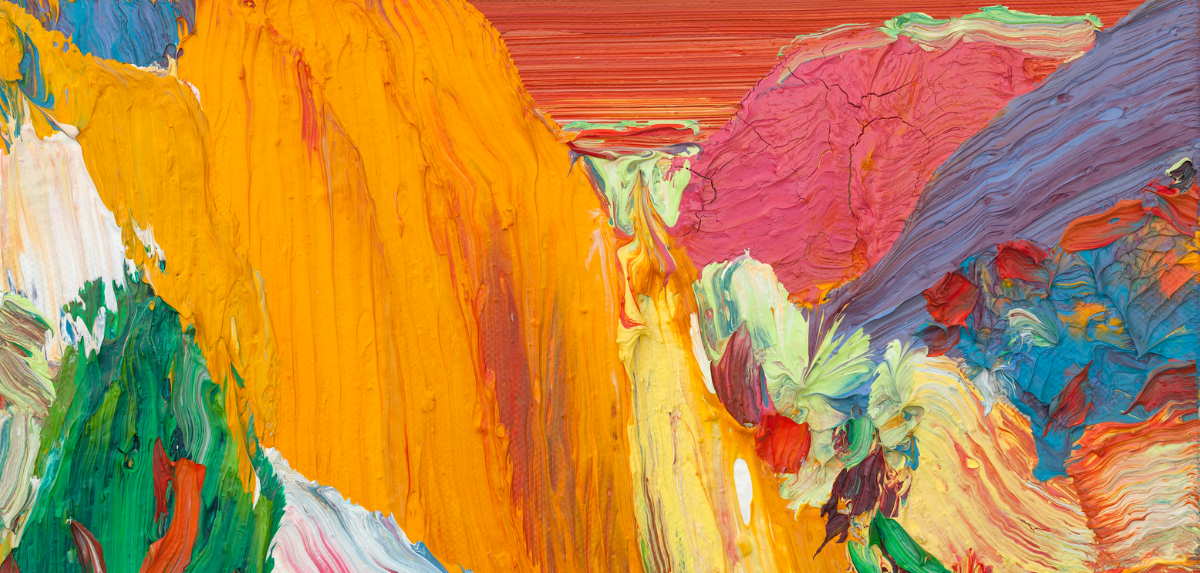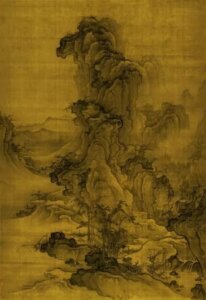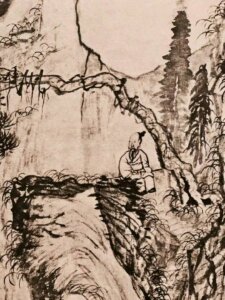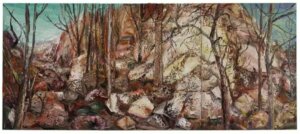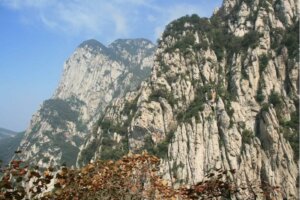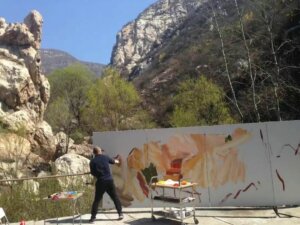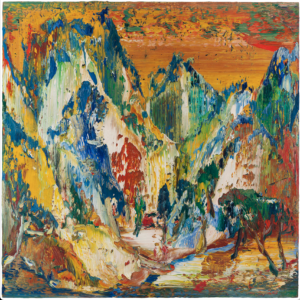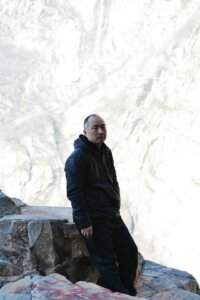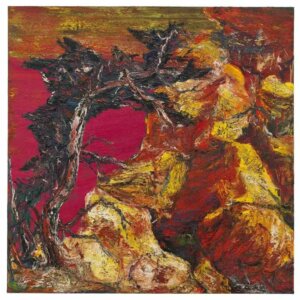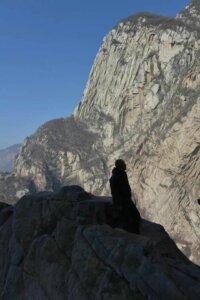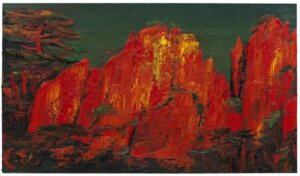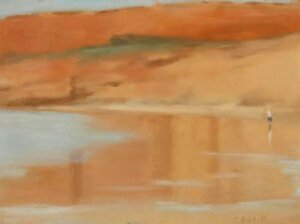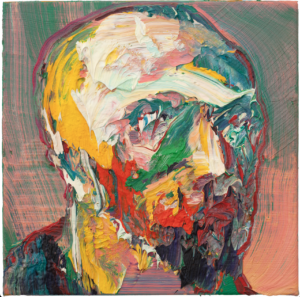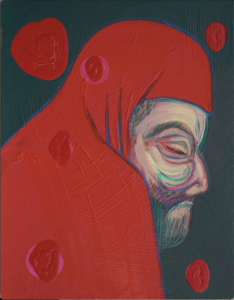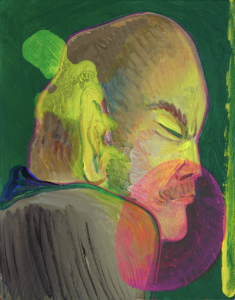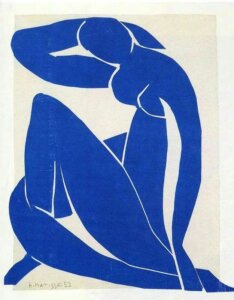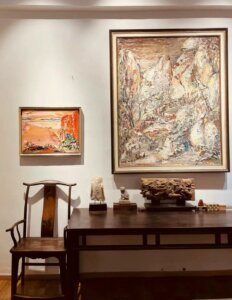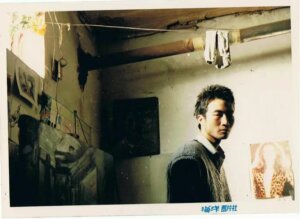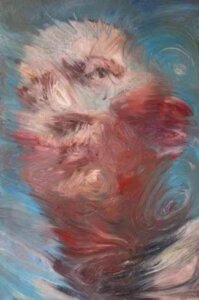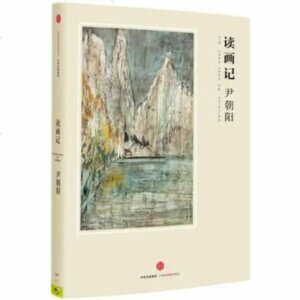“I hoped that by bringing Shan Shui (landscape painting) back to our generation, we create something different.” – Yin Zhaoyang
The leading figure of the 1990s trend of avant-garde paintings, Cruel Youth movement, Yin Zhoyang has been active in the forefront of Chinese contemporary art.
To mark Yin Zhaoyang’s first solo exhibition in Australia, Soul Mountain, Vermilion Art interviewed the artist currently based in London remotely.
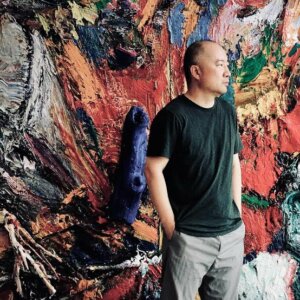 Yin Zhaoyang
Yin Zhaoyang01
“I hoped that by bringing Shan Shui (landscape painting) back to our generation, we create something different.”
Vermilion Art: Over the recent years, a significant portion of your works are focused on landscapes, including the series we are currently exhibiting. When creating works, do you prefer immersing yourself in nature and letting it blend in with your work, or do you find yourself more inclined to paint in your studio?
Yin Zhaoyang: Over the past 12 years, I have consciously engaged in plein air painting almost every year. This practice is inspired by an ancient Chinese art concept called “行旅” (xing lv) which emphasizes the necessity of engaging in a dialogue with nature.
Vermilion Art: Like a form of spiritual cultivation, would you say?
Yin Zhaoyang: That’s a valid interpretation. The Chinese understanding of landscape painting differs from that of Western landscape art. Landscape painting has served as a spiritual symbol for the Chinese throughout history. It is closer to the religious beliefs of ancient literati, representing a vital aspect of the Chinese soul. Each generation interprets landscape painting in its own way. I hoped that by bringing Shan Shui back to our generation, we create something different.
In contrast to traditional Chinese literati who used ink as their sole medium, we have the flexibility to use oil, ink, installation, and various other mediums. Having undergone the study and influence of contemporary Western art, our perspectives and reflections of the world should differ from the past. Art should carry more spiritual depth, reflecting one’s thoughts on the era and humanity. Such work can engage in discussions within the realm of contemporary art, which is our fundamental starting point at that time.
Guo Xi (1020-1090), Early Spring, from the Northern Song Dynasty (960-1276)
Work from Shi Tao, from the Ming Dynasty (1368-1644)
Yin Zhaoyang, Qingluan Autumn Temple No.2, 2013
Shi Tao once said, “Brush and ink should follow the times”. Meaning you must modernize. One point I consistently emphasize is that you must be a modern individual. The landscapes you see should no longer be limited to the styles observed by ancient literati such as Guo Xi, Fan Kuan, Shen Zhou, or Shi Tao. Simply put, you’ve already travelled by plane, you have broadened so your spatial awareness will differ significantly from the ancients. This alone puts us at a different starting point, with many more avenues for exploration.
02
“From painting of Mount Song, I express a worldview.”
Mount Song, Henan, China
Vermilion Art: You have painted both Mount Hua, and more often, Mount Song. Is this due to a sentimental attachment to your hometown, or is there a backstory behind your decision? Why Mount Song?
Yin Zhaoyang: Over the past 12 years, I intentionally chose to paint Mount Song, mainly within a valley of Mount Song. I wanted to see how it would change over the 12 years of observing the exact scenery at a specific location. It was the influence of Cézanne. Painting Mount Song doesn’t have much to do with me being from Henan. It would be too limiting If I were only trying to represent my hometown because I’m from Henan. Whether it’s Mount Song or any other place, in the end, it’s not essential. Mount Song is just my starting point; what matters most is that Mount Song inspired me.
Yin Zhaoyang sketching en plein air in Mount Song
Yin Zhaoyang, The Green, 2020, oil on canvas, 120×120 cm
I still go to other places for plein air painting every year. These experiences combined, form a comprehensive outline for viewing the world. Whether painting in the studio or outdoors, the interaction between the two should go beyond merely portraying the landscapes of one’s hometown. We should transcend this. I am a person of this era, and when facing nature and human environments, my thoughts should have no limits.
Vermilion Art: You seem to be someone who enjoys challenges.
Yin Zhaoyang: I believe that deep within, the problem setting should be ultimate. My focus has always been on people and landscapes. Essentially, when you face the world, it’s all landscapes.
Yin Zhaoyang in Mount Song
Yin Zhaoyang, Pine and Stone, 2013
Vermilion Art: In 12 years of observing the changes in that mountain range, nature inspired you and allowed you to express yourself. When observing Mount Song, have you also been observing yourself? If so, what changes have you witnessed in yourself over the last 12 years?
Yin Zhaoyang: There are very noticeable changes. On one hand, I’ve become less talkative and more composed, and my use of language has receded. Every time I go, friends from the local area sometimes come to see me painting that mountain valley. Many people paint, and some gradually stop. Faced with the same scenery, if your approach, thoughts, or feelings have stayed the same, it’s repetitive. As time goes on, the urgency to explore oneself becomes more pressing. It’s an artistic project, a deliberate one. Cézanne’s painting of Mont Sainte-Victoire influenced me a lot, and there’s also the repetition theme from Huang Binhong. In art history, many great artists, after expanding the inspiration gained from a certain point or place, essentially present their entire worldview. It was a simple idea when I started, and I just went for it. Now, it’s been almost 12 years. When I held an exhibition at the Long Museum two years ago, I counted and had probably been there nearly seventy times. Thinking about it, it’s quite a lot.
Yin Zhaoyang in Mount Song
Yin Zhaoyang, Red Pine, Long Museum Collection
Vermilion Art: In Australia, there’s an artist like Clarice Beckett, a female artist from Victoria. In the 1920s, she lived near Brighton in Melbourne. She pushed her easel from home to the seaside and painted there every day. She did this for two to three decades. She passed away at a young age, and her father, with a match, burned almost all of her paintings. Fortunately, some were saved. About ten years ago, this artist was discovered, and the Art Gallery of South Australia held her exhibition. She presented works from a small region, yet each piece expressed a unique spirit. Now, she receives considerable attention.
Clarice Beckett, Wet sand, Anglesea, 1929
Yin Zhaoyang: I believe human emotions can be limitless and can be unearthed. Recently, I’ve been looking at an American artist Georgia O’Keeffe; she paints in the desert, and her works naturally convey a sense of continuity and great perception. For some, entering a specific place can trigger a new eruption. I’m not a fan of gimmicks or montages. What matters to me is whether you are willing to put yourself in to emotionally invest.
03
“Figures, mountains, or trees are all closely connected in my eyes.”
Vermilion Art: In your current solo exhibition, there are some portraits of Van Gogh. Why did you choose Van Gogh, and what influence does he have on you?
Yin Zhaoyang, Van Gogh Portrait, 2023, oil on canvas, 40.5×40.5 cm
Yin Zhaoyang: Before 2010, I mainly painted figures. I painted many figurative works and then moved on to painting Mount Song. With the study of landscapes, new feelings emerged. My exploration of Van Gogh started three years ago, around 2020. He serves as a transitional figure. Through the theme of Van Gogh, I hope to encapsulate the past 12 years of my understanding of figures and landscapes. It has become a vessel to showcase these changes. I realise that at this stage, figures, mountains, or trees are all closely connected in my eyes.
Yin Zhaoyang, Luohan No.1, 2023, acrylic on board, 41×32 cm
Yin Zhaoyang, Luohan No.2, 2023, acrylic on board, 41×32 cm
Vermilion Art: You’ve explained it particularly well. People often categorize figures and landscapes as entirely separate entities. When selecting works for this solo exhibition, we discussed how there’s a subtle connection between your landscapes and the portraits of Van Gogh. It’s not a stark distinction; they have a delicate and intricate relationship.
04
“I have been deeply influenced by a long line of Eastern and Western masters, from Northern Wei murals, Huang Binhong, to Matisse and Cézanne.”
Vermilion Art: We’ve learned that you’ve studied art history before, and your published book “Boiling Wine, Discussing Heroes” discusses many classical artists. Have you picked up any techniques or methods from classical masters?
Yin Zhaoyang: Let me clarify that I didn’t formally study art history. I am self-taught in this aspect. After graduating from the art academy, I realized I needed to understand it, so I bought books and studied on my own. Art history at the academy was quite dull. I basically studied Chinese painting history and Western painting history. For people of our age, the modernist part is more familiar. Contemporary art, especially in the last twenty years, has been challenging to accept personally. It’s my limitation.
Henri Matisse, Blue Nude II, 1952
On the other hand, the classical art you mentioned is a question every contemporary artist cannot avoid. I have many favorites, and the list is quite long. For example, I like Giotto, Angelico, and Francesca from the Renaissance and modern and contemporary Western artists. Before our graduation, we were influenced by many modern masters. I particularly like the recent exhibition of Matisse at 798, and then Cézanne, Van Gogh, and Munch, etc. This is more towards the expressive side. I also like Soutine from the Paris School at that time. After graduating from the academy, the artists who influenced me the most were Bacon and Richter. This is something that can be traced from my practice.
A corner of Yin Zhaoyang’s studio
In the last ten years, the influence of traditional Chinese painting has been more significant. I revisited classical Chinese art, from the Tang Dynasty to the Northern Wei murals, ancient stone carvings, and more. Emotionally, these are closer and easier to interact with as a Chinese.
05
“I had to learn to make my own path.”
Vermilion Art: We understand that you had early influences from your family, especially your father, regarding your interest in art. Is that correct?
Yin Zhaoyang: A little bit. For people of our generation, we must put it in the context and environment of that time. If you don’t get into a school, stay in a small city in the western part of Henan, you won’t have any opportunities. The goal was not necessarily to become an artist; the primary goal was to survive and leave that place. That was the initial motivation. Any talk about singing praises for art was just empty words. However, once I engaged in it, I became deeply committed. I have a deep feeling for the pain of this country. As you can see in the photos I sent you, I lived in a 12-square-meter small room near Guangqumen with a friend when I first arrived in Beijing. That was the actual reality at that time.
Yin Zhaoyang in Beijing, 1990
Vermilion Art: I know some artists had to go hungry.
Yin Zhaoyang: Of course, we were hungry too. Another senior artist once said he often went to other people’s homes to eat before becoming famous. What if I have no place to go for a meal? You could have a meal one day and starving the very next. This was very typical. This was the reality. So, my early paintings – Cruel Youth series – made sense in this context.
Vermilion Art: Your talent in art is undoubtedly outstanding. If you pursued another profession and left Henan, do you think you would have done just as well?
Yin Zhaoyang: Probably. Maybe even better. Art has its limitations; some things need to go against the tide. Sometimes, it cannot be evaluated purely by realistic standards.
Vermilion Art: Do you consider yourself a confident person?
Yin Zhaoyang: I am forced to be.
Vermilion Art: How so?
Yin Zhaoyang: Because I am quite independent. This has been the case since I entered the Central Academy of Fine Arts.
Vermilion Art: Not mingling with the crowd.
Yin Zhaoyang: Right. Not mingling with the crowd. I like to fight alone. My requirements are few. As long as I can paint.
Vermilion Art: Although you mentioned that there have been many challenges, twists, and turns, from my reading and impression, you gained fame quite early (in the late 1990s) and have been a very avant-garde artist. How did you attract so much attention and recognition?
Yin Zhaoyang: In fact, when I graduated, it was very difficult. I wasn’t someone whom galleries immediately promoted. I was from the grassroots. However, I was very determined. Where there’s a will, there’s a way. I followed my feelings, followed the rules. What are the rules of art? Ultimately, you have to be yourself, not find a shortcut. I was like a cat in that village, teaching in a preparatory class for the academy while painting by myself. My first chance to exhibit was at an art fair in Beijing. It was not like today’s art fairs where you have Richter on one side and a room full of peonies on the other. It was a mix of everything. And individual artists could apply. I applied and borrowed money from three people, a total of nine thousand yuan, to participate.
Early work of Yin Zhaoyang
Vermilion Art: Which year was this?
Yin Zhaoyang: 1997, a year after I graduated. I rented a cart for twenty yuan, a tricycle in Beijing, and went with a fellow villager with twenty paintings. I had no capital, and at that fair, I only sold one painting, so I ended up in debt. It wasn’t until 2001 that I held my first solo exhibition. From 2001 to 2003, I participated in about two exhibitions a year. At that time, I was very committed, thinking that fundamental rule needed to be clear. An artist is essentially a reflection of their time. You need to convey pulsation of the era to have value. Every year, I hoped to show the creative process and see progress. In this regard, I hope to live longer.
Vermilion Art: Do you care about or accept how others label and associate you with? For example, the “Cruel Youth” movement.
Yin Zhaoyang: I think it doesn’t matter. When we look at past masters, each stage of their career is eventually summarized and put into a certain category or school. I feel you need to have your own judgment about your professional career. You must decide what kind of artist you want to be, which probably affects your judgment of art.
Vermilion Art: In the early 1990s, when contemporary Chinese art first gained international attention, it could be said that artists gained recognition, or even greater acknowledgement, in China after gaining the West’s recognition to some extent.
As a younger-generation artist, you have started from scratch, as you mentioned, without significant external impetus, and now you have a strong presence. Is it due to personal reasons or the circumstances of the times?
Yin Zhaoyang: I think it’s a combination of personal reasons and the push of the times. Everyone cannot choose the era they live in. This era is in constant flux, and there should always be a kind of resistance. This resistance will help you maintain independence. In the end, what do I hope for? I still hope to survive first, and then have continuous expression. Throw and immerse yourself into it as much as possible, and in the end, force yourself out. In between, you need a bit of luck. It seems that I still have a bit of luck.
06
“Writing has little impact on my creativity, but maintaining thoughtfulness is part of an artist’s job.”
Yin Zhaoyang’s ‘Reading Painting’
Vermilion Art: I’ve read some of your art critique books and articles; the writing is excellent. It’s quite rare for artists to write art critiques, which is very commendable.
Yin Zhaoyang: My academic performance could have been better, but my Chinese reading has always been decent. I’ve read quite a few books. I am preparing for the second book now, a sequel.
Vermilion Art: That’s great. Does writing have any impact on your artwork? Or is it just a hobby in your spare time?
Yin Zhaoyang: It has some impact. In fact, I believe this is part of an artist’s job. If you have thoughts, you express them; even if that influences one person, that’s something gained. The process of writing is different from painting. There can be a lot of self-questioning during this process.
Vermilion Art: Does it help you to reflect on your creation?
Yin Zhaoyang: To be honest, it doesn’t help much. True creation, as I understand it, starts with your life force, not your understanding of it. Art has no necessary connection with what you comprehend rationally. So, I attribute it to the life force. It’s your perception, which might come from a wrong perspective, and that’s okay.
Vermilion Art: It’s more of an emotional expression rather than a mathematical formula.
07
“A good artist needs to be true to oneself.”
Vermilion Art: I would like to ask one last question. From the first time I saw you, including our conversation today, you leave a lasting impression. You seem to embody the perspective of a master artist. Have you ever thought about how people, maybe in fifty years or even later, would perceive your art?
Yin Zhaoyang: From my experience, it’s been about thirty years, and I consider myself a beneficiary of this profession. I’ve read many biographies of artists, but you shouldn’t think about this question while you’re still alive. Nowadays, everyone seems to have anxiety about entering art history. A senior collector said something a few days ago that I agree with. He said, “Art history is a shackle forged in gold.” When we were in our twenties and thirties, as young practitioners, there was a natural rebellion. We want to be different from the previous generation and prove ourselves. At this stage, I feel very relieved. Do what you should do. Going back to that phrase: respect common sense. If you appreciate common sense, many things you do can touch others and be very moving.
Another thing is, as an artist, your perspective must be relatively open. You need to understand your profession, which is the natural charm of art. Resisting authority, resisting habits, resisting art that puts on makeup is a job that artists must do. A good artist needs to be true to oneself.
Vermilion Art: Today’s conversation with you has been extremely insightful. Thank you very much.
